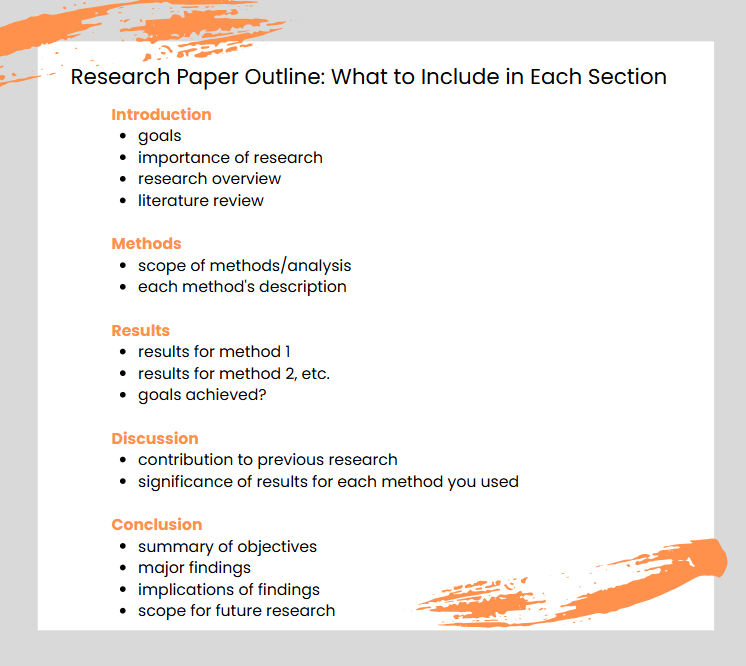A research paper outline is a detailed plan or framework that organizes ideas and supporting details of your project before the writing process begins. The purpose is to ensure logical flow, maintain focus, and help you develop arguments and analysis throughout the paper.
It’s not that challenging for experienced researchers to craft, but aspiring scientists or college students can face several pitfalls during the process. While this AI tool can help you with the research paper outline ideas and structure, it won’t be superfluous to know how to create it yourself, do you agree? So, let’s reveal the details of essay outline writing and learn what text structure to use.

Why Write an Outline for a Research Paper?
Why do you need an outline for your research paper?
When you conduct research, you collect a lot of information and ideas, including sources with reliable evidence to support your thesis, arguments, and claims you’ll discuss and prove throughout the paper. A research outline can help you:
- Organize your thoughts better
- Understand the flow and levels of information in your research
- Ensure that you don’t miss anything while writing
- Prepare a well-structured, neatly organized manuscript
Researchers write outlines to see the logical ordering of the information they’ll discuss and arrange everything into a hierarchy. What should the audience read first? What’s most essential? Which idea or argument would be better to place closer to the end to complete the research most effectively?
So, preparing an outline for your paper will help you write it better and faster, keeping track of all the information. Let’s learn how you can create it.
5 Steps to Creating a Perfect Outline for Your Paper
1. Brainstorm your subject
Before you start structuring your outline, it’s critical to determine the purpose of your paper and the audience you’ll be writing for. It will help you develop the thesis and understand what ideas to include in the paper to support it.
Once you have a thesis, list all the ideas you’ll include, organize the related ones together, and gather primary and secondary sources you’ll use as evidence to support them throughout the paper.
2. Organize that information into sub-groups
Arrange the materials in subsections for a hierarchy and logical flow. Move from abstract to concrete and general to specific, but remember that everything you write in your paper should be relevant and relate to your thesis.
Tip: Write down specific quotes or passages you highlighted from your sources during research. While they aren’t a must to include in your outline, they’ll save you time when you write the draft: You won’t get distracted from the process as all the notes are at hand.
3. Create the framework
Start with a framework rather than writing a detailed outline of your paper at once. Given that you know the core components your paper should include, put them together to have a clear look at the backbone of your future project.
Make a list of all the sections in your paper:
Try to follow the IMRaD format, according to which your research paper should include the following major components: Introduction, Methods, Results, [and] Discussion. There should also be a Conclusion. This is the basic outline for your research paper.
4. Add the details
Next, write down the main facts, points, or arguments you’ll cover under each section. You can structure the sections like paragraphs, sentences, or short points — whatever is more comfortable for you to work with.
What should you talk about in the introduction?
- The importance of your research
- The goals of your paper
- An overview of your paper’s organization
- A literature review (what other researchers have already said about your topic)
In the Methods section, you need to discuss the scope of your methods and analysis and describe each primary method you used in your research.
What about the Results section? Here, do your best to report each method’s results. Also, remember to mention whether you were able to achieve the goals of your research.
In the Discussion section, you need to focus on:
- How your study contributes to existing research in the field
- How significant are your results for each method
The final section of your research paper is what writers know as a Conclusion. In this paragraph, you must tie it all together. Sum up the objectives of your paper, list your core findings, and share the implications of the study findings. Also, mention the scope of further research on the same topic.
Your research outline is now ready, and this is how it looks:

5. Revise and improve if necessary
Check your outline to ensure you haven’t missed anything critical and see if you need to add or change anything. Double-check the arguments, evidence, and the order you choose to present them:
Is it logical? Will it be clear for the audience to understand your ideas? Is your chosen structure the best one to communicate your findings, especially if you’re writing for an audience who may be unfamiliar with your topic? It may be worth adding background or context before presenting new findings.
Once your outline is ready, it’s time to start writing a research paper.
Hint: It’s okay to revise some points, delete or add ideas, polish arguments, or use other sources while writing. Don’t be afraid to deviate from your outline while writing a draft. If you have new ideas or arguments during the process that fit logically into the outline and you realize that they will only improve your work if you mention them, do so.
A research paper outline is the framework, after all. It’s a plan you created for yourself, so it’s up to you to adjust it if necessary.
How to Format Your Outline: 3 Core Structures to Choose From
Okay, let’s face it:
There are also cases when you don’t write an outline for yourself, but should submit it to teachers or committees for approval. How should you structure and format your research paper outline in that case?
Consider any of these three structures:
- Alphanumeric
- Full-sentence
- Decimal
The difference between them relates to your writing style. It’s fine to use any of them if it’s relevant to your needs and if it follows the requirements prescribed by your task.
Alphanumeric is the most common structure for outlines. Here, you’ll use letters (capitalized and lowercase) and numerals (Roman and Arabic) to organize the information. Write in short notes rather than complete sentences. Like this:
I. Body paragraph
A. First point
1) Sub-point
a) Sub-point of subpoint 1
The full-sentence structure is the same as alphanumeric, but with sentences rather than short points in each sub-section.
Decimal is like alphanumeric but with a different numbering system. Instead of letters, you’ll use the following hierarchy:
1. Body paragraph
1.1. First point
1.1.1. Sub-point of that first point
1.1.2. Sub-point of that first point
1.2. Second point
As well as alphanumeric, the decimal structure prescribes writing in short points, not complete sentences or paragraphs for each point or sub-point.
It’s Your Turn!
We hope this information will help you craft a stellar outline for your next research paper. Consider all the must-have components and organize all the ideas, arguments, and evidence hierarchically and logically. Ready to start writing? Let your new research strike the academic community!

